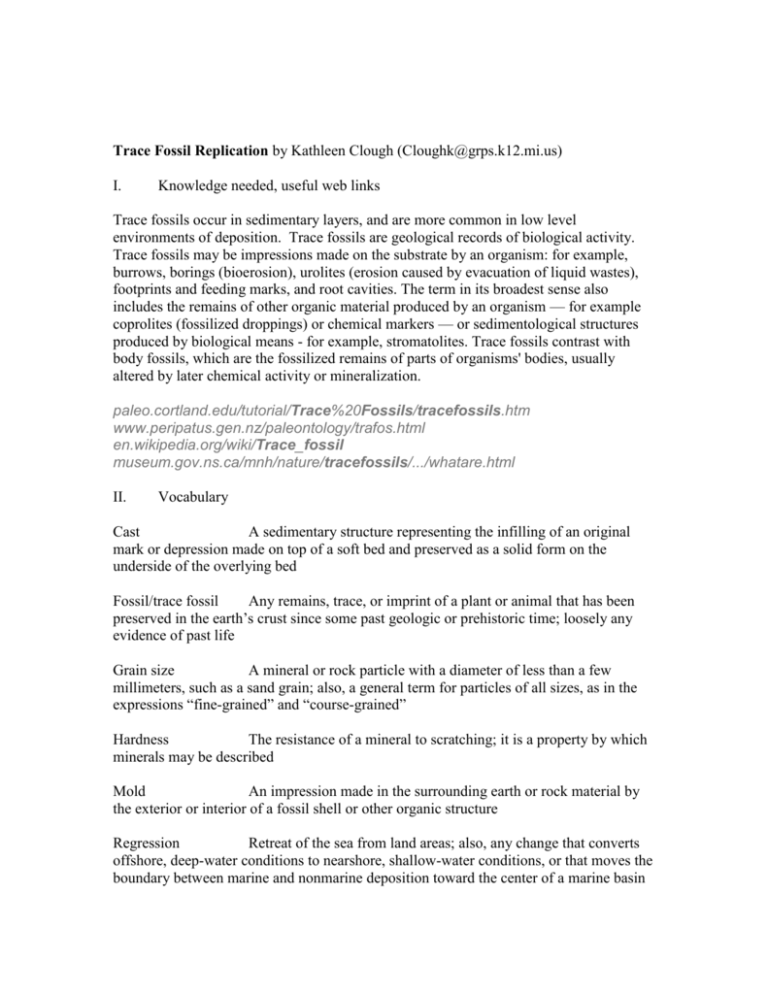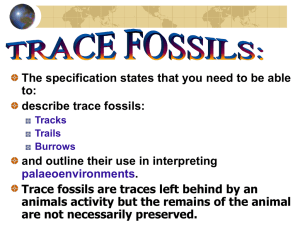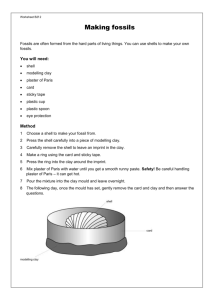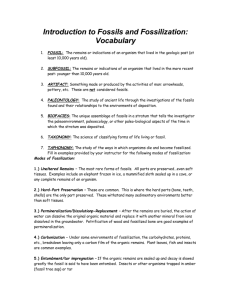Trace Fossil Lesson Plan - MSTA Conference
advertisement

Trace Fossil Replication by Kathleen Clough (Cloughk@grps.k12.mi.us) I. Knowledge needed, useful web links Trace fossils occur in sedimentary layers, and are more common in low level environments of deposition. Trace fossils are geological records of biological activity. Trace fossils may be impressions made on the substrate by an organism: for example, burrows, borings (bioerosion), urolites (erosion caused by evacuation of liquid wastes), footprints and feeding marks, and root cavities. The term in its broadest sense also includes the remains of other organic material produced by an organism — for example coprolites (fossilized droppings) or chemical markers — or sedimentological structures produced by biological means - for example, stromatolites. Trace fossils contrast with body fossils, which are the fossilized remains of parts of organisms' bodies, usually altered by later chemical activity or mineralization. paleo.cortland.edu/tutorial/Trace%20Fossils/tracefossils.htm www.peripatus.gen.nz/paleontology/trafos.html en.wikipedia.org/wiki/Trace_fossil museum.gov.ns.ca/mnh/nature/tracefossils/.../whatare.html II. Vocabulary Cast A sedimentary structure representing the infilling of an original mark or depression made on top of a soft bed and preserved as a solid form on the underside of the overlying bed Fossil/trace fossil Any remains, trace, or imprint of a plant or animal that has been preserved in the earth’s crust since some past geologic or prehistoric time; loosely any evidence of past life Grain size A mineral or rock particle with a diameter of less than a few millimeters, such as a sand grain; also, a general term for particles of all sizes, as in the expressions “fine-grained” and “course-grained” Hardness The resistance of a mineral to scratching; it is a property by which minerals may be described Mold An impression made in the surrounding earth or rock material by the exterior or interior of a fossil shell or other organic structure Regression Retreat of the sea from land areas; also, any change that converts offshore, deep-water conditions to nearshore, shallow-water conditions, or that moves the boundary between marine and nonmarine deposition toward the center of a marine basin Sediment liquid Solid material that has settled down from a state of suspension in a Transgression The spread of sea over land areas Viscosity internal friction The property of a substance to offer internal resistance to flow; its III. Goal of Lesson The goal of the lesson is for students to create trace fossils, infer the environment of deposition, and to estimate energy level needed to preserve fossil records. IV. Curriculum Connections E.SE.06.11 Explain how physical and chemical weathering lead to erosion and the formation of soils and sediments. (Pictured Rocks dunes) E.ST.06.31 Explain how rocks and fossils are used to understand the age and geological history of the Earth (timelines and relative dating, rock layers). (Mosquito River, Hurricane River, Chapel, Miners) SRSM.1 Reflecting on knowledge is the application of scientific knowledge to new and different situations. Reflecting on how knowledge requires careful analysis of evidence that guides decision-making and the application of science throughout history and within society. (Grand Sable Dunes, Hurricane River, Mosquito River) SIPM.1 Inquiry involves generating questions, conducting investigations, and developing solutions to problems through reasoning and observation. (Fossil replication, soil profiles, conservation, particle movement or sieving) E.ES.07.13 Describe how the warming of the Earth by the sun produces winds and ocean currents. (Energy to move particles, wind and waves) E.ES.07.41 Explain how human activities (surface mining, deforestation, over population, construction and urban development, farming, dams, landfills, and restoring natural area) change the surface of the Earth and affect the survival of organisms. (Ghost forest, National Parks, soil profiles, erosion) E1.1h Design and conduct a systematic investigation that tests a hypothesis. Draw conclusions from data presented in charts or tables. (Fossil replication, soil profiles, particle movement) E3.1A Discriminate between igneous, metamorphic, and sedimentary rocks and describe the process that change one kind of rock into another. (Soil profiles, rock identification, erosion rates) E3.3C Describe the motion of geologic features using equations relating rate, time, and distance. (Dune migration, water movement, particulate movement) E2.1B Analyze the interactions between the major systems (geosphere, atmosphere, hydrosphere, biosphere) that make up the Earth. (Interaction with water, wind, and soil and rock) E2.4B Explain how the impact of human activities on the environment (e.g. deforestation, air pollution, coral reef destruction) can be understood through the analysis of interaction between the four Earth systems. (Conservation, erosion, decay) E5.4B Explain natural mechanisms that could result in significant changes in climate (e.g. major volcanic eruptions, changes in sunlight received by Earth, and meteoric impacts). (Rock identification, energy) E5.3D Describe how index fossils can be used to determine time sequence. (Mosquito River, Grand Sable Dunes, Hurricane River) V. Materials and Technologies Tupperware containers or paper plates Sand Plaster of Paris powder Fossil imprint (e.g. shell, ripple marks, leaf imprint, foot or hand print) Shredded paper or leaf litter Small paint brush Mixing bowl and spoon IV. Procedures/ Instructions Initial conversation about what a fossil is, using accountable talk. Possibly show a variety of pictures and have the students categorize them, (foot prints, ripple marks, trees, shells, fish, worms, dinosaur bones). Include time in the discussion, (e.g. how long does it take to make a fossil? What type of environment might it happen in?) Distribute materials separated into group tubs, one tub to about four students. Have students create a data chart with space enough for sketches. Include drying time, depth and width of impression, fill method, viscosity or amount of water. Students should decide what type of imprint they will use, and sketch it into data chart. Fill the basin with sand about an inch thick, and create the desired impression. Measure the width, and depth of the impression and record. Determine viscosity desired for two different samples, mix plaster of paris for first trial, and record the amount of water used. Determine method of fill for impression, pouring, dumping, or dry with water added later. Optional (cover impression with leaf litter or shredded paper). Fill impression with plaster, allow plaster to dry, and harden. While waiting for first sample to dry, prepare second tray with the same impression, and prepare second plaster of paris mixture. Using the same method of fill complete second impression sample, and allow sample to dry. While waiting for plaster to dry, discuss what possible differences that could be found in the samples. Once plaster is dry remove the sample from the basin. Using small paint brush students should remove remaining sand or leaf litter from plaster cast. Examine casts and note any differences. Examine one other group’s samples that used a different fill method, and discuss methods used to create them. Compare plaster mixtures and record findings. If time and materials allow, students can try alternate fill methods and different viscosities. If time and materials allow, students can alter composition of fill material by adding debris, (e.g. pebbles, leaves, rocks). Answer questions and complete data chart. VII. Hands-on Connections Sketch of impression Width of impression Depth of impression Viscosity of fill Method of fill Depth of impression Viscosity of fill Method of fill Second group’s findings Sketch of impression Width of impression How did the viscosity of plaster influence quality of impression? ________________________________________________________________________ ________________________________________________________________________ ________________________________________________________________________ ________________________________________________________________________ ________________________________________________________________________ How did the method of filling impression influence quality of impression? ________________________________________________________________________ ________________________________________________________________________ ________________________________________________________________________ ________________________________________________________________________ ________________________________________________________________________ How did the type of impression influence preserved sample? ________________________________________________________________________ ________________________________________________________________________ ________________________________________________________________________ ________________________________________________________________________ ________________________________________________________________________ Do different fill rates influence quality of impression preservation? ________________________________________________________________________ ________________________________________________________________________ ________________________________________________________________________ ________________________________________________________________________ ________________________________________________________________________ What energy level of filling would produce the best trace fossils? ________________________________________________________________________ ________________________________________________________________________ ________________________________________________________________________ ________________________________________________________________________ ________________________________________________________________________ What viscosity of fill material would produce the best casts of trace fossils? ________________________________________________________________________ ________________________________________________________________________ ________________________________________________________________________ ________________________________________________________________________ ________________________________________________________________________ VIII. Assessment Rubric Data Inferences Implications EX Organized, clear record of data in table Well thought through and clearly explained Impact of fill on trace fossil clearly explained Good Poor OK record of testing Minimal data, not done in table clear, scattered Thought out, and explained Impact of fill on trace fossils OK explanation Minimal connections, little thought No explanation of impact fill has on trace fossil production









